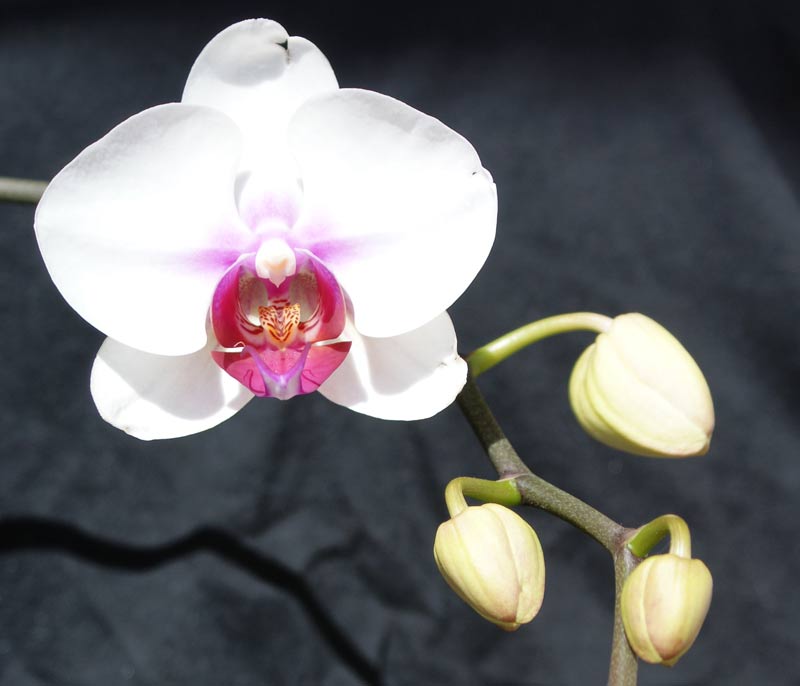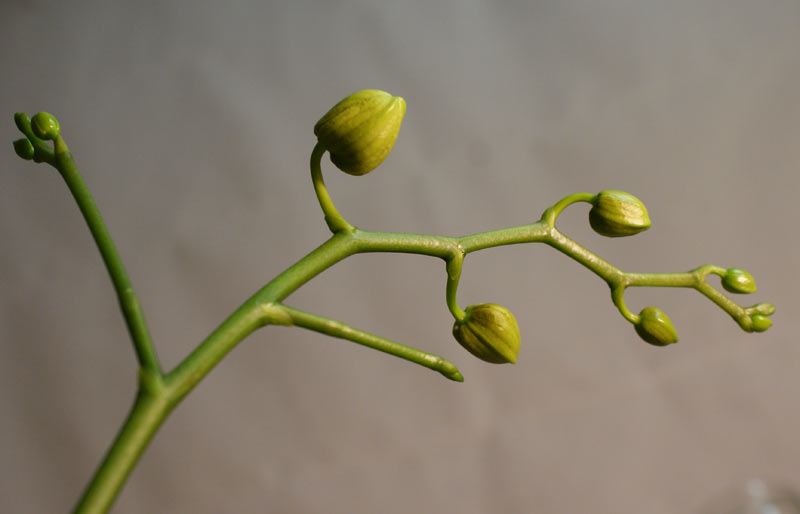
** This post is written and edited by a human being **
It’s exciting to pick a new orchid in the shop. Choosing which one to buy is understandably based on the type of flowers it has – there are so many different colors and patterns to choose from!
Once the new plant is brought home you naturally want to enjoy the flowers for as long as possible. And that’s why I’d like to answer a few frequently asked questions about orchid flowers.
Why are your orchid’s flowers falling off? If the flowers are falling off prematurely, you’re experiencing bud blast. This is caused by a sudden change in environment. A drastic change in temperature, light or humidity can shock the orchid, making its flowers and buds fall off.
Older orchid flowers fall off naturally once they’re done blooming, starting from the closest to the crown towards the tip of the spike. They should fall off one by one. This is not the same than bud blast, but a totally natural occurrence.
The old flowers should never fall off all at once, and if even your orchid buds are falling off before opening up, you know with 100% certainty you’re experiencing bud blast.

My orchid hasn’t bloomed in 2 years
Phalaenopsis orchids should bloom every year, in some cases even a few times a year, but sometimes they simply refuse to grow a new flower spike. There are several factors that can cause this.
- Root problems
- Insufficient light
- Stable temperature
- Pests
- Stress
First and foremost, I would advise you to check the roots of your orchid. Their condition reflects the overall health of your plant.
By repotting your orchid you get a chance to inspect the roots properly and trim off all the bad roots. Fresh potting medium can also help perk up the plant.
Indoor orchid growers’ biggest challenge is to provide enough efficient light for their plants. And this applies especially during seasons with not much natural sunlight.
So investigate your light sources – if you think you need more light, buy a grow light for indoor plants and see if it makes any difference. They don’t cost much and can truly transform your orchids.
A steady drop in night temperature is needed to induce spiking. So if you have a very stable temperature in your house, this explains why your orchid isn’t blooming under your care.
You need the night temperature to drop for a steady period of two weeks. You can manipulate this by reducing the heat on your radiators at nighttime, or leaving the window slightly open. If the night temperature in the orchid room is always 71.6F (22C), it should drop down to 62.6F (17C) over a period of two weeks.
Once a spike has emerged and starts to grow, the nightly temperature drop isn’t needed anymore.
A hidden pest issue may also affect blooming. This is because the insects attack the plant and therefore impact its overall health. Some pests also go into the flowers and begin to feast on them.
So make sure there’s nothing lurking in your orchid pot. If you detect any pests, unusual marks, or webbing, identify the intruder and take immediate action to exterminate it.
If your orchid has experienced a lot of stress recently, it may not bloom the following year. Stress can be caused by many factors, such as diseases, pests, environmental factors, and root loss. Even if your orchid appears stable now, it is not guaranteed that it is ready to produce a bloom.
I have had a few cases like this, mainly with rescue orchids that lacked a proper root system. It took a lot of time and care, and a continued stable environment, before they were ready to bloom again.
With cases like this, you simply need patience. Give the plant some time to recover and become stronger. When it’s ready, it will bloom again.
Orchid has buds but won’t bloom
If the buds have dried up and are still attached to the flower spike, this is caused by bud blast we talked about in the beginning of this article.
Once the buds have dried up, there’s, unfortunately, nothing you can do to revive them. If they haven’t fallen off by themselves, you can remove them from the spike by hand.
However, if the buds still look fresh and plump, you have nothing to worry about. It takes a few months for a flower spike to fully develop, from the moment it starts to grow all the way to the flowering stage.
So even when the buds have been formed, it takes time for them to develop before they can open. There’s no way to speed this part up, so just sit back and wait.
What to do after orchid bud blast
It is unfortunate to be hit by a bud blast, but this is something every orchid grower will experience at some point.
The buds and flowers are sensitive to environmental changes. A bud blast can even happen while you transport a brand-new orchid home!
If the dried flowers or buds are still attached to the spike, you can remove them manually.
There is a chance that new buds will grow out from the tip of the flower spike, so you can let the spike be as it is.
Or, alternatively, you can trim back the spike above the closest node to where the first flower grew from. Cut from an inch above the node. This can induce a secondary spike, which is like a branch on the spike, giving you more flowers.
The third option is to cut off the whole spike from as close to the base as possible.
Though you can get more flowers from the old spike, they might not be as big or impressive as the first ones were.
This is why some orchid growers opt to cut off the entire spike as soon as the bloom is finished. But ultimately, it’s up to you.
To read more about trimming flower spikes, please see HERE
When experiencing bud blast, I highly recommend you to investigate why it happened.
Make sure it wasn’t caused by something you do on a regular base, like turning up the heat too much or keeping the window open on a cold day – you want to minimize doing things that can potentially cause bud blast.

Orchid flower spikes
In the orchid world, the term ‘flower spike’ means the part where the flowers grow. In other plants, this part might be referred to as a ‘stem’ or ‘branch’. But with orchids, it’s called a ‘spike’, or ‘flower spike’ to be exact.
Flower spikes start to grow out from in-between the orchid leaves. They can grow pretty long, depending on what type of orchid you have.
The longest I know of is over 3 feet (0.91 m) long! It takes a few months for them to grow and reach the blooming stage. The bloom can last from two months to a half year, depending on the orchid and the environment it is in.
Once the bloom has finished, the flower spike will begin to die back. Your orchid will grow new spikes in the future, sometimes more than one at the same time.

Orchid care after bloom dies
So your orchid has finished blooming, and maybe you even got some more flowers from a secondary spike. It’s time to cut off the flower spike because it has no function anymore.
Sterilize your scissors/pruners and cut the spike from as close to the base as possible.
Seal the cut mark with powdered cinnamon (the kind you use for baking too). Cinnamon helps close up the wound faster, preventing bacterial infections, etc.
If you needed to repot your orchid before it bloomed, now it’s the perfect time to repot it.
Use this chance to inspect the roots properly; check for pests and trim off all the roots that are mushy or dehydrated.
Spray the roots with Hydrogen peroxide 3% and pot the plant in fresh potting medium.
If you’re reusing the old pot it’s important to wash/disinfect it before use.
Water the plant and put it back on its place. Your orchid will now start to focus its energy on growing new roots and leaves.
If you don’t fertilize on a regular base, you can now add some weak fertilizer in the water.
Remember, you don’t have to repot your plant after it has finished blooming. Do it only if you needed to do it anyway before the orchid spiked.
Whether you needed to repot due to broken down potting medium or overgrown roots, it’s always best to postpone it if a spike emerges – to avoid the risk of losing the blooms!
To read more about WHEN to repot, please see HERE
HOW to repot, step-by-step guide, please see HERE
Final Words
I hope this article has answered some of your questions regarding orchid flowers. The blooming stage is exciting and even rewarding. I still get so much joy every time I see a new spike emerge!
At the beginning of my orchid journey, the flower spikes truly tested my patience – simply because it takes so long for them to reach the blooming stage! But by doing so, orchids have also taught me patience.
Good things are worth waiting for!
You need to allow the plant to determine the speed of things. Just give them enough time, love, and care, so they can ‘do their thing’ in peace and naturally.
Thank you for reading. Happy blooming, orchid friends!





Hi there, just wanted to mention, I loved this blog post. It was helpful.
Hi Cathern. Thank you, so glad to hear that!
thank you soooo much! I got a pot of live orchids for my birthday and the flowers lasted for 2 months! I was shocked and had no idea orchids’ flowers can last that long. I never had orchids before and did not know what to expect. Anyways, after 2,5 months of blooming the plant started dropping flowers. I was terrified. Your article game reassurance that it is just a natural process. The only thing I am confused about is – how do I know the plant needs to be re potted? How do I know it has overgrown roots? I do not want to disturb the roots for no reason.
Hi Florida
Yes that’s the beauty of orchid flowers – they can last for months! 🌸
What comes to repotting – maybe this article would help you;
When To Repot My Orchid
And if you end up repotting, then see this article;
How To Repot My Orchid
Overgrown roots would be pushing out of the pot! Or when you look through the clear plastic you’d see it’s full of roots.. But the other reason for repotting is to give the plant fresh potting medium. But this needs to be done only every 1-2 years, max 3. The article above explains it in more detail! Good luck. 😊
Thank you for this article. I’ve had my orchids for about 4 or 5 months and the flowers started falling off one by one. Nice to know it wasn’t something I did wrong.